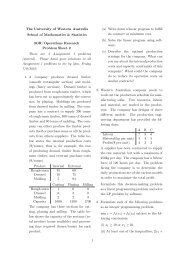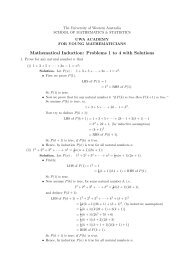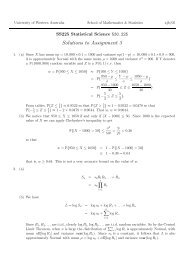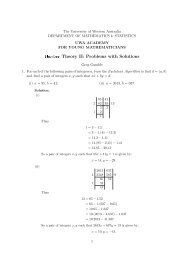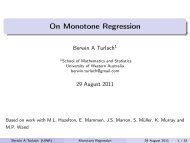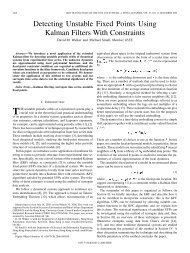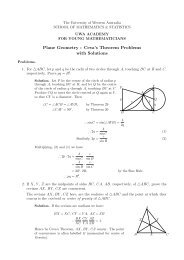mathematica introduction - School of Maths and Stats Local Site
mathematica introduction - School of Maths and Stats Local Site
mathematica introduction - School of Maths and Stats Local Site
You also want an ePaper? Increase the reach of your titles
YUMPU automatically turns print PDFs into web optimized ePapers that Google loves.
IntroFowkes.nb 1<br />
MATHEMATICA INTRODUCTION<br />
N.Fowkes <strong>and</strong> G.Keady, University <strong>of</strong> Western Australia<br />
The online-help is good. For example, the complete Mathematica User Manual is available via the help system. To use it<br />
though, you need to start Mathematica ...<br />
To start Mathematica in the MCL, double-click on the Mathematica icon using the copy on the Lab System local hard<br />
disk (as loading <strong>of</strong> the <strong>Maths</strong> Lab server is currently too slow). When the Mathematica window appears, activate the<br />
kernel by entering a simple calculation (1+1) <strong>and</strong> press ENTER. . WAIT! (about 1 min) Eventually Mathematica will<br />
produce::<br />
1+1<br />
2<br />
i.e. it names your input (1+1) <strong>and</strong> produces an output (2). Note the outline shape <strong>of</strong> the right bracket ] while Mathematica<br />
is working.<br />
You can then proceed with your calculations.<br />
‡ A USEFUL UWA URL<br />
UWA's Physics Dept makes extensive use <strong>of</strong> Mathematica.<br />
The introductory Notebooks <strong>of</strong> Paul Abbott's course<br />
http://www.pd.uwa.edu.au/Physics/Courses/Third_Year/Computational_Physics.html<br />
e.g. Basic .. Calculations sections <strong>of</strong> the first <strong>introduction</strong> to Mathematica notebook there are another place for you to<br />
look for introductory examples. Look through this h<strong>and</strong>out first, though.<br />
‡ HOW TO RUN Mathematica ON YOUR HOME PC<br />
There is a Student price for the s<strong>of</strong>tware. Best place in Perth to buy is<br />
http://www.analytica.com.au/<br />
The version <strong>of</strong> the s<strong>of</strong>tware in use in MCL is Mathematica 4.0. Mathematica 3.0 <strong>and</strong> upwards is recommended.
IntroFowkes.nb 2<br />
‡ HELP<br />
1. For beginners, the most useful first item is the Getting Started from the Help menu <strong>and</strong> going to the "Tour <strong>of</strong> Mathematica"<br />
there.<br />
2. For help with individual functions, for example with a function whose name begins with "Nam", type<br />
Nam*<br />
Nam* for more help,<br />
N* for help on all <strong>of</strong> the functions beginning with N..<br />
3. For help on <strong>mathematica</strong>l functions, use the Function Browser under the Help menu.<br />
4. To stop a calculation use `Control,' .<br />
5. To quit, select Quit from the File menu.<br />
6. Balloon Help can be used in connection with what is on the menus in the FrontEnd.<br />
‡ ELEMENTARY CALCULATIONS<br />
Pi+2^2+1/2+3 4<br />
33<br />
ÅÅÅÅÅÅÅ<br />
2 + p<br />
An exact calculation. Note that Pi cannot be written exactly. Note that a space (or *) denotes multiplication. Note also<br />
that an initial capital letter is used for Mathematica functions. You should use small letters for the expressions you<br />
introduce. Enter needs to be pressed to complete the calculation, <strong>and</strong> labels Out[1], In[1] are introduced by the program.<br />
To get a numerical approximation use:<br />
N[%]<br />
19.6416<br />
N evaluates the expression approximately. % denotes the previous output. %% the output before this etc. %n denotes<br />
Out[n]. Note that a square bracket [] is used for arguments <strong>of</strong> functions.<br />
ü VARIABLES, EQUATIONS<br />
eq=x^2 +b*x +1<br />
1 + b x + x 2<br />
Solve[eq==0,x]<br />
99x Ø ÅÅÅÅ<br />
1 è!!!!!!!!!!!!!!!<br />
I-b - -4 + b<br />
2 2 M=, 9x Ø ÅÅÅÅ<br />
1 è!!!!!!!!!!!!!!!<br />
I-b + -4 + b<br />
2 2 M==
IntroFowkes.nb 3<br />
Note the == used for an equation. The single = assigns the value x^2 +b*x +1 to eq . Note that the outcome <strong>of</strong><br />
Solve is presented as a list, the 2 solutions, in curly {} brackets. We can now input a particular numerical value <strong>of</strong> b (9<br />
say) (by using the operator /. <strong>and</strong> b->9 <strong>and</strong> evaluate approximately use the N operator:<br />
N[%] /. b->9<br />
88x Ø -8.88748
IntroFowkes.nb 4<br />
Show[p1,Frame->True]<br />
1<br />
0.5<br />
0<br />
-0.5<br />
-1<br />
-3 -2 -1 0 1 2 3<br />
Ü Graphics Ü<br />
The ``option '' Frame introduces a frame about the graph. Use Options to see about options. For surface <strong>and</strong> contour<br />
maps ask for help about Plot3D, ParametricPlot3D, ContourPlot. Also check up on the Show, AxesLabels,<br />
PlotLabel, Viewpoint Options.<br />
ü LINEAR ALGERA<br />
m={{a,b},{c,d}}<br />
88a, b
IntroFowkes.nb 5<br />
ans =DSolve[ {<br />
y''[t] +40*y'[t] +625*y[t]==100*Cos[10*t],<br />
y[0]==0, y'[0]==0 },<br />
y[t], t]<br />
99y@tD Ø ÅÅÅÅÅÅÅÅÅ<br />
1<br />
697 ‰-20 t J84 ‰ 20 t Cos@10 tD - 84 Cos@15 tD + 64 ‰ 20 t Sin@10 tD - ÅÅÅÅÅÅÅÅÅÅ<br />
464<br />
3<br />
yans = y@tD ê. ans@@1DD ;<br />
Plot@yans, 8t, 0, 1.2
IntroFowkes.nb 6<br />
eq=x^2 +b*x +c<br />
c + b x + x 2<br />
the expression for eq we want.<br />
4. Equations use a double equals sign.<br />
There is much more to Mathematica than this. There are details concerning Palettes <strong>and</strong> Notebooks you may find<br />
useful. Whole 'interactive engineering h<strong>and</strong>books' have been prepared using these facilities.<br />
However, in M28n our approach is to encourage you to learn the CAS from applying it to help you solve typical<br />
'engineering maths' problems, <strong>and</strong> to provide a gentle <strong>introduction</strong> via a systematic set <strong>of</strong> labs. These are at<br />
http://maths.uwa.edu.au/~keady/M28p<br />
in a password protected area. The login is m28n, the password is m28n****



